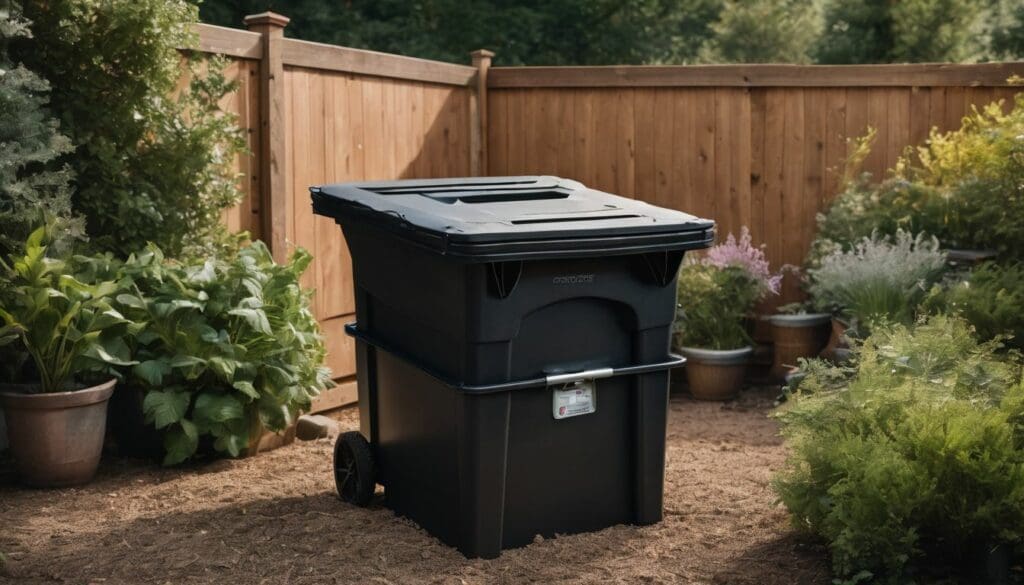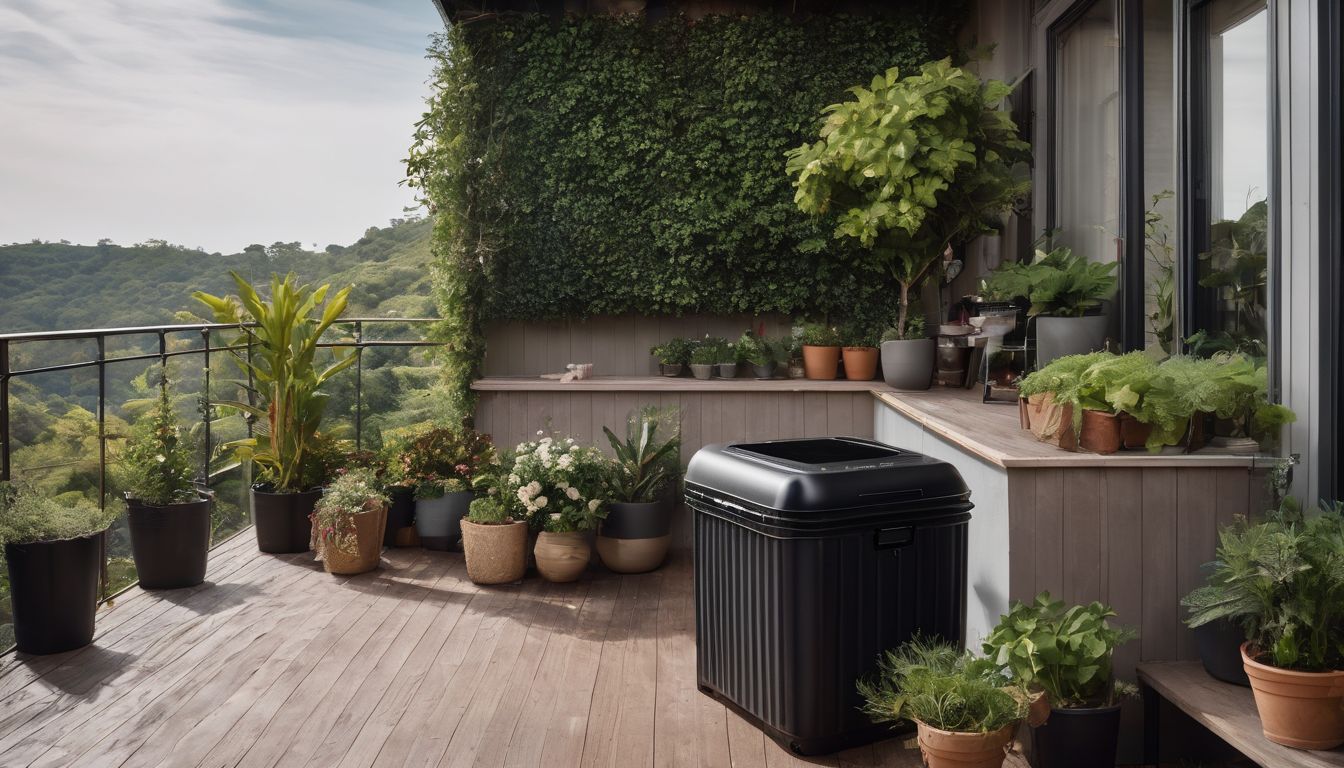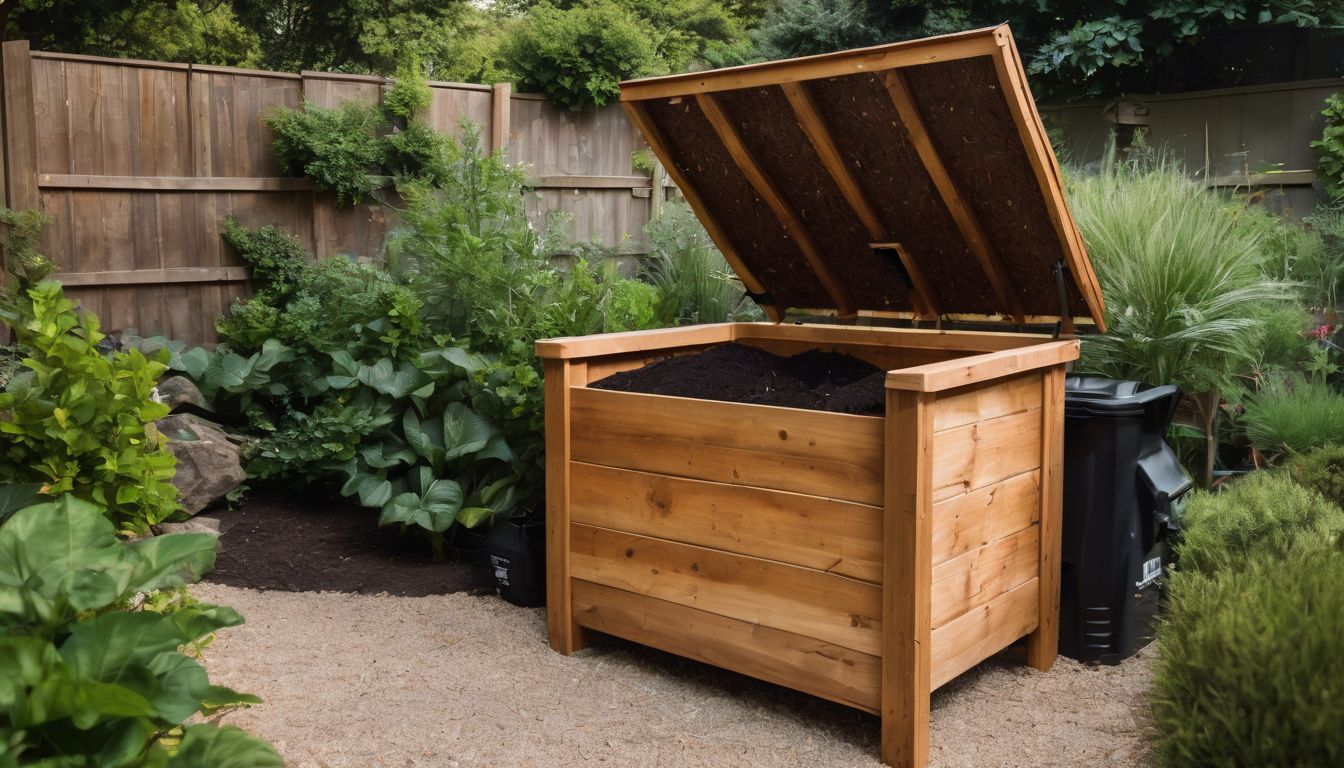Are you finding uninvited critters sneaking into your compost bin? A healthy compost attracts a variety of pests, from fruit flies to rodents, seeking food and shelter. Our guide provides practical steps to secure your compost and keep it pest-free without harming the environment.
Keep reading; let’s win this garden battle together!
Key Takeaways
- Avoid adding food scraps like meat, dairy, and oily items to your compost bin as these attract pests; instead, add more ‘browns’ such as dried leaves to reduce odours.
- Regularly aerate and turn the compost pile to disrupt breeding grounds for pests and maintain a favourable decomposition environment.
- Use wire mesh or hardware cloth underneath the bin as a physical barrier to prevent rodents from burrowing.
- Employ natural methods like diatomaceous earth or spraying with orange oil around the bin’s perimeter to repel insects without harming beneficial organisms.
- Build a DIY rat-proof compost bin by using materials with tight-fitting lids, keeping it elevated off the ground, and positioning it in shaded areas to decrease pest attraction.
Why Pests Are Attracted to Compost Bins
Pests are attracted to compost bins because they provide food sources, warmth, moisture, and shelter. This makes them the perfect environment for pests like insects, rodents, and wildlife to thrive and reproduce.
Food sources
Compost piles become a feast for pests because they often contain kitchen scraps like fruits, vegetables, and eggshells. These organic waste items emit odors that attract animals and insects from afar.
You’ll find that maintaining the right balance in your compost is crucial; too many green materials such as food leftovers can lure unwanted visitors.
To keep these critters at bay, be selective with what goes into your bin — meat, dairy products, and oily foods are a no-go as they’re notorious for drawing pests. Instead, focus on adding more ‘browns’ like dry leaves or straw to reduce smells and maintain an environment less appealing to wildlife.
Properly managing your compost pile not only helps with pest control but also contributes to environmental sustainability by turning waste into rich soil for gardens.
Warmth and moisture
Warmth and moisture create an ideal environment for pests to thrive in your compost bin. The combination of these factors promotes the breakdown of organic matter, attracting insects and rodents seeking food, water, and shelter.
Moist conditions also contribute to the decomposition process, but they can also draw unwanted pests.
Control warmth and moisture levels by aerating the pile regularly to maintain sufficient airflow and managing moisture content to discourage pests. Covering the bin with a tarp during heavy rain prevents excess saturation.
Shelter
Position your compost bin away from potential shelters for pests, such as dense vegetation or clutter that may provide cover and a breeding ground. Ensure the area around the bin is clear to discourage pests from making it their home.
Implementing this simple step can significantly reduce the risk of unwanted wildlife seeking refuge near your compost pile, helping to maintain a pest-free environment for effective waste management.
Moving on to “How to Prevent Pests from Getting into Your Compost Bin,” let’s explore further strategies to keep your compost free from unwanted visitors.
How to Prevent Pests from Getting into Your Compost Bin
To prevent pests from getting into your compost bin, avoid adding certain foods like meat and dairy products. Keep the bin away from bird feeders and pet bowls, and aerate and turn the pile regularly.
Place wire mesh or hardware cloth under the bin to keep pests out.
Avoid adding certain foods
To prevent attracting pests to your compost bin, avoid adding certain foods such as meat, dairy products, and oily or greasy items. These can emit strong odours that attract unwanted wildlife.
Additionally, refrain from putting in pet waste or any diseased plants as they may introduce harmful pathogens into the compost pile.
Consider focusing on plant-based kitchen scraps, fruit and vegetable peels, coffee grounds, tea bags, eggshells, and yard waste. By being mindful of the types of materials you add to your compost bin, you can significantly reduce the likelihood of attracting pests while still creating nutrient-rich soil for your garden.
Keep compost bin away from bird feeders and pet bowls
Place your compost bin at a distance from bird feeders and pet bowls to reduce the risk of attracting unwanted pests. It’s essential to minimise the availability of food sources in the vicinity, as this can help prevent wildlife from being drawn to your compost pile.
By keeping these potential attractions separate, you can effectively discourage pests and maintain a cleaner composting environment.
To safeguard against infestations, it is crucial to be mindful of the surrounding area where your compost bin is placed. Taking preventative measures like this can significantly aid in pest control and ensure that your efforts towards environmental conservation are not compromised by unwanted intruders.
Aerate and turn the pile regularly
Regularly aerating and turning your compost heap is crucial in preventing pests from taking up residence. This process helps to speed up decomposition while creating an environment that’s less attractive to pests by increasing airflow and breaking down any pockets of moisture where bugs may thrive.
A well-aerated compost heap also generates heat, which discourages pests from nesting. Additionally, turning the heap mixes the materials thoroughly, ensuring even decomposition and minimising odours that can attract unwanted critters.
Maintaining proper aeration and regular turning not only speeds up the composting process but also creates an unwelcoming environment for pests, making it essential for keeping your compost bin pest-free.
Place wire mesh or hardware cloth under the bin
To further secure your compost bin from pests, place wire mesh or hardware cloth underneath it. This will create a physical barrier to prevent rodents and other creatures from burrowing into the compost pile.
The sturdy material will also discourage digging animals like raccoons and skunks from gaining access to the delicious organic matter inside. By adding this protective layer, you can effectively deter wildlife and keep your compost pile safe and undisturbed.
In addition to aerating and turning the pile regularly, implementing wire mesh or hardware cloth underneath the bin serves as an essential step in pestproofing your compost area. This simple action can significantly minimise the risk of unwanted animal intrusions while maintaining a healthy environment for decomposition.
Natural Methods to Deter Pests
To keep pests away from your compost bin, you can use natural methods like adding diatomaceous earth, using homemade gnat traps, increasing brown content and bone meal, as well as spraying with orange oil.
These natural deterrents help to repel pests while maintaining the quality of your compost.
Adding diatomaceous earth
To deter pests, add diatomaceous earth to your compost bin. This natural substance is effective in repelling insects and deterring crawling pests like ants and cockroaches. The sharp edges of diatomaceous earth particles cut through the exoskeletons of insects, causing them to dehydrate and die.
Sprinkle a thin layer on top of your compost material or mix it in to create an inhospitable environment for pests without harming the beneficial organisms within your compost.
Next up is “Using homemade gnat traps” which provides a DIY approach to keeping unwanted bugs out of your compost bin.
Using homemade gnat traps
To deter pests, consider using homemade gnat traps. These traps can be made by filling a jar with apple cider vinegar and a few drops of dish soap. Cover the jar with plastic wrap and secure it with a rubber band.
Then, poke several small holes in the plastic wrap to attract and trap gnats. Additionally, placing containers filled with soapy water near your compost bin can also help catch and drown adult gnats.
Regularly replacing the solution in these traps will aid in effectively controlling gnat populations around your compost pile without the use of harmful chemicals.
Increasing brown content and adding bone meal
To deter pests, increasing brown content in the compost bin is an effective method. Brown materials like dried leaves, straw, or shredded paper create a more balanced carbon-to-nitrogen ratio, making the environment less appealing to pests.
Additionally, adding bone meal can help repel scavenging animals due to its strong scent and gritty texture. These natural methods not only discourage pests but also contribute to healthier compost.
This approach minimises wildlife intrusion and ensures that your compost remains undisturbed while attracting beneficial decomposers such as earthworms and microorganisms. By incorporating these steps into your compost management routine, you can maintain a pest-free environment without resorting to harmful chemicals or deterrents.
Spraying with orange oil
Spray your compost bin with orange oil to deter pests. Mix 2 to 3 tablespoons of orange oil with a gallon of water, then use a spray bottle to apply the solution around the bin’s perimeter.
The citrus scent acts as a natural repellent for insects and rodents, keeping them away from your compost. Regular application may be necessary, particularly after heavy rainfall or when you notice pest activity.
Increase the effectiveness by spraying orange oil inside the bin on top of the compost material. This will discourage pests from nesting in your compost while adding a pleasant aroma to neutralise any odours that may attract wildlife.
DIY Rat-Proof Compost Bin
Create a rodent-proof compost bin by using a metal or plastic container with a tightly fitting lid, elevating it off the ground and storing it in a shaded area. For more tips on keeping pests away from your compost bin, read on!
Using a metal or plastic bin with a tight-fitting lid
A metal or plastic bin with a tight-fitting lid is effective in keeping pests out of your compost. This prevents access for rodents and larger animals, limiting the potential food source.
The secure lid also helps to control odors and prevent attraction of unwanted wildlife.
Elevating the compost bin off the ground further discourages pests from accessing the contents. Placing it on a platform or using legs can help deter burrowing animals and insects, reducing the risk of infestation while providing better airflow for the composting process.
Elevating the bin off the ground
Elevate your compost bin off the ground to deter pests such as rodents and insects. Place the bin on bricks, blocks, or a platform to create an inaccessible barrier for pests. By keeping it elevated, you can prevent pests from burrowing into the compost pile and reduce the risk of attracting unwanted wildlife.
Crafting a rodent-proof compost bin is crucial for maintaining a pest-free environment – ensuring that your efforts in composting remain undisturbed by wildlife interference.
Storing bin in a shaded area
Place your compost bin in a shaded area to regulate temperature and reduce moisture, discouraging pests from making it their home. This also helps minimise odours that can attract unwanted wildlife and insects, promoting a healthier compost environment.
Shading the bin prevents overheating during hot weather, maintaining an optimal balance for decomposition while deterring garden pests and rodents from invading or disrupting the process.
Creating a shaded haven for your compost bin supports its natural breakdown process and minimises the risk of attracting pests, contributing to a more harmonious and sustainable approach to waste management in your garden.
Conclusion
In conclusion, managing your compost pile well can prevent pests from making it their home. Securing a tightly fitting lid on the bin and keeping it off the ground will deter rodents.
Use natural repellents like diatomaceous earth to keep insects at bay. Regularly turning and aerating the compost pile will maintain proper decomposition and reduce odors that might attract pests.
FAQs
1. How do I prevent pests from getting into my compost bin?
To prevent pests in your compost, make sure to rodent-proof your bin and manage your compost heap by covering food scraps properly and maintaining the right moisture level.
2. What can I add to my compost to keep bugs away?
Sprinkle hydrated lime over your compost heap occasionally; it works as an insect repellent and helps control odours that attract pests.
3. Are there ways to deter wildlife from being attracted to my compost?
Yes! Keep a tight lid on the bin, use wildlife exclusion methods like fencing, and secure the composter in a way that discourages animals from trying to get in.
4. Can managing bugs in my compost help with overall pest prevention?
Absolutely! By minimising pests in the compost bin through regular stirring and proper balance of green and brown materials, you’ll be better at repelling animals and keeping bugs under control.
5. Why is odour control important for protecting my composite from pests?
Controlling odours is key because strong smells can attract rodents and other wildlife. Manage waste correctly by burying food scraps deep within your heap to avoid unwanted attention.





